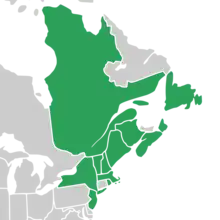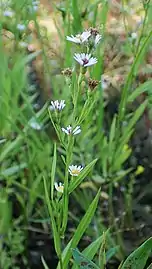Symphyotrichum tradescantii
Symphyotrichum tradescantii (formerly Aster tradescantii) is a species of flowering plant in the family Asteraceae native to northeastern North America. Common names include Tradescant's aster and shore aster.[3]
| Symphyotrichum tradescantii | |
|---|---|
 | |
| Scientific classification | |
| Kingdom: | Plantae |
| Clade: | Tracheophytes |
| Clade: | Angiosperms |
| Clade: | Eudicots |
| Clade: | Asterids |
| Order: | Asterales |
| Family: | Asteraceae |
| Tribe: | Astereae |
| Subtribe: | Symphyotrichinae |
| Genus: | Symphyotrichum |
| Subgenus: | Symphyotrichum subg. Symphyotrichum |
| Section: | Symphyotrichum sect. Symphyotrichum |
| Species: | S. tradescantii |
| Binomial name | |
| Symphyotrichum tradescantii | |
 | |
| Native distribution[2] | |
| Synonyms[2] | |
|
Basionym
Alphabetical list
| |
Description
Symphyotrichum tradescantii is a perennial, herbaceous plant that may reach 5 to 70 centimeters (2 to 28 inches) tall. Its flowers have white ray florets and pale yellow to purple disk florets.[3]
Distribution and habitat
Native
Symphyotrichum tradescantii is native to northeastern North America in Canada (New Brunswick, Newfoundland, Nova Scotia, and Québec) and the United States (Maine, Massachusetts, New Hampshire, New Jersey, New York, Rhode Island, and Vermont).[2]
Introduced
It is an introduced species in the Czech Republic, Slovakia, Slovenia, and Croatia.[2]
Habitat
S. tradescantii is found in wet and rocky habitats such as shores, streams, and freshwater estuaries.[3]
Citations
References
- Brouillet, L.; Semple, J.C.; Allen, G.A.; Chambers, K.L.; Sundberg, S.D. (2006). "Symphyotrichum tradescantii". In Flora of North America Editorial Committee (ed.). Flora of North America North of Mexico (FNA). Vol. 20. New York and Oxford: Oxford University Press. Retrieved 19 January 2021 – via eFloras.
- Hassler, M. (2020). "Symphyotrichum tradescantii (L.) G. L. Nesom – World Plants: Synonymic Checklists of the Vascular Plants of the World". In Roskov, Y.; Ower, G.; Orrell, T.; Nicolson, D.; Bailly, N.; Kirk, P.M.; Bourgoin, T.; DeWalt, R.E.; Decock, W.; van Nieukerken, E.J.; Penev, L. (eds.). Species 2000 & ITIS Catalogue of Life, 1 December 2020. ISSN 2405-8858. Retrieved 19 January 2021.
{{cite book}}:|journal=ignored (help) - NatureServe (2 July 2021). "Symphyotrichum tradescantii Tradescant Aster". NatureServe Explorer (explorer.natureserve.org). Arlington, Virginia: NatureServe. Retrieved 15 July 2021.


